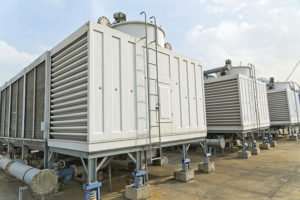

Evaporative towers, or also cooling towers, are a classical closed circuit cooling system, a very much employed solution in the industrial sector: it allows indeed to dissipate large amounts of heat involving a minimum energy consumption, enabling water cooling at a temperature below the ambient air temperature, through water consumption by evaporation.
The functioning of a cooling tower exploits the latent heat of evaporation to achieve a significant cooling effect, with on the other hand a moderate consumption of water.
An evaporative tower offers an excellent efficiency with a low energy demand, but requires a careful and constant control of the recirculating water, which must be kept clean to avoid scaling and deposit sediments. Nowadays, there are several automated systems for the monitoring of recirculating water, minimizing the maintenance or anyway broadening the maintenance intervals.
In these machines, the water to be cooled goes through the tower falling down by gravity, giving up a part of its thermal load to the air coming up from the bottom, achieving thermal transfer for direct contact between the two fluids.
This thermal exchange happens in part by convection (or by sensible heat) between the hot water and the cold air (causing an increase on air’s temperature), but in most part exploiting the evaporation latent heat: the evaporation latent heat is the amount of heat stolen from air to achieve water evaporation, while a portion of the water is transferred to the air in form of vapor, absorbing heat.
Evaporation happens thanks to the pressure gap between the water vapor, within the border layer of air in direct contact with water, and the pressure of aqueous vapor contained in ambient air. The process goes on until the two pressures reach the same value, in other words until the saturation level of humidity in the air is reached. This status corresponds to the wet bulb temperature of the air, which is the lowest water temperature that in theory can be obtained thanks to the evaporation process.
This condition is achieved when the water temperature and the temperature of the border layer reach the wet bulb temperature of the air, a condition that arrests the evaporation process.
The air flow employed in evaporative towers can be obtained in several ways, in a natural way for convection or artificially by means of fans. When using fans, different construction geometries are possible, determining the type of tower, with induced or forced draft.
From an energy consumption point of view, an evaporative tower is a thermal machine offering an excellent ratio between the electrical energy installed and the thermal energy dissipated, and therefore is an excellent solution to dissipate large amounts of thermal energy at mid-low temperatures. These features make it clearly a winning solution in a bunch of application sectors, where production processes don’t need extreme cooling to achieve very low temperatures, but involve high amounts of heat to be dissipated.
